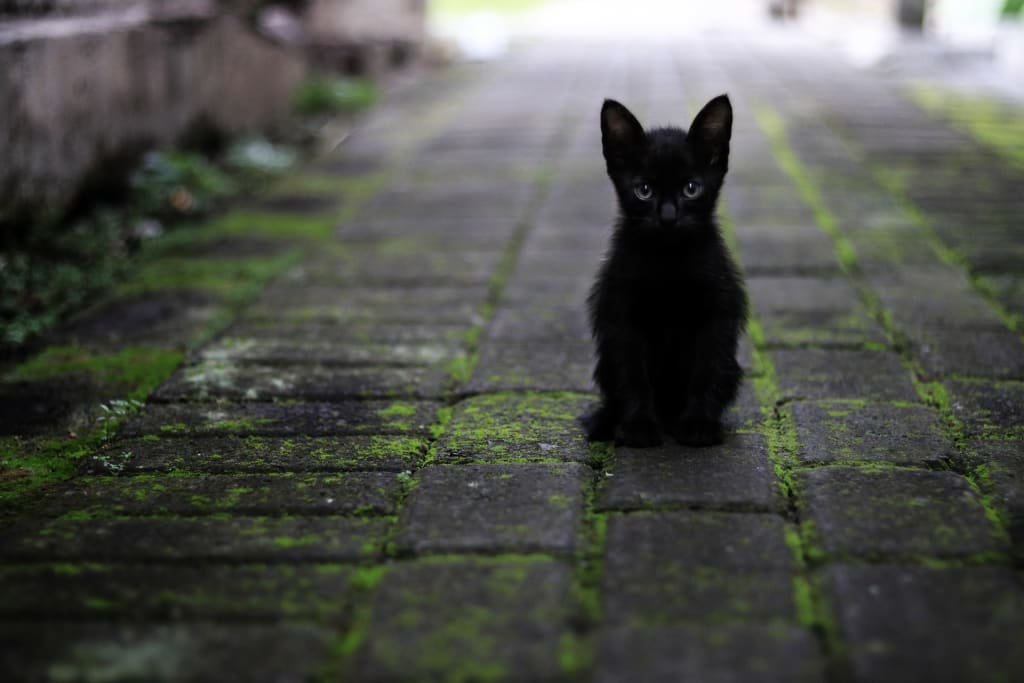The Last Cat
Felis Catus - Geronimo Jones, Age 7, The Last Cat on Earth

It had happened so fast. Within a year every cat (but one) on the face of the earth was either dead or in the process of dying. The newly discovered virus, Feline Leukemia Virus - variant AB.8 (FLV-Ab8), was found to be responsible for the deaths. Most scientists believed the virus had arisen naturally, a mutation or series of mutations of the commonly circulating Feline Leukemia virus, which, though often fatal, is not all that transmissable, and for which a highly effective vaccine exists. A small but vocal minority of scientists were convinced the virus was the result of a bioweapons research program. They claimed the virus had managed to escape its home lab either by acccident, or that it had been released intentionally. Most pointed the finger at Russia and China as both were known to have or have had active bioweapons research programs, and they remain two of the very few countries where laboratory research using cats (domestic cats) as test subjects is still allowed and fairly common. In truth, the bioweapons crowd had some strong arguments in their favor. There were elements of the FLV-Ab8 genome that had sequence signatures indicative of human intervention. Most troubling however was the speed and mechanisms by which the virus mutated within the infected host to evade its' immune system. This was something that had never seen in a naturally occuring virus before. Virologists and molecular biologists would be studying and learning from this virus for a very long time to come. In the now however, the virus' impact was devastating and every cat was affected equally. By every cat, I mean every cat, from the most common domestic to the most exotic wild species, each and every one of the 37 cat species comprising the family Felidae was gone or soon to be gone, forever. This included, among others, cheetahs, pumas, jaguars, leopards, lions, lynxes, tiger, and domestic cats, living in any region of the world, and cats are native to almost every region on Earth, with the exception of Australia and Antarctica. I say forever because all attempts at cloning had failed, and though each species' genetic material had been saved and frozen in cryogenic storage, it would be hundreds, perhaps thousands of years before technology would advance to the stage where this material could be used to produce the cats again. The ecological impacts were significant and mostly just beginning to be felt. Rodent populations had boomed out of control in many important agricultural regions resulting in untold levels of crop destruction, starvation, and putting several countries on the brink of war. Resource competition between countries contributed to greatly rising tensions world wide. Diseases the rodents transmit such as plague and hanta were on the rise, and there were many more predicted impacts, along with surely many, many more that remained unforseen. The earth, however, would persevere, it would adapt, we would adapt, we would survive the loss of the cats, as painful as it might be.
The ecological and physical impacts of the loss were but one aspect of the death of all cats. As important, and just as impactful, was the devastating emotional trauma caused by the loss on the millions or billions of cat lovers world wide who had come to love their domestic cat companions like family. Suddenly they found themselves stripped of this part of their family. Within one year they had lost each and every one of their beloved pets, trusted companions, playful friends, and sources of emotional support. Many domestic cat owners had gone to incredible lengths to try and protect their cats from the dreaded virus. Unconfirmed rumors suggested that a group of ultrarich cat lovers from around the world had banded together, and spent hundreds of millions of dollars to build the equivalent of a feline biodome, with disease protections modeled on the the United States Centers for Disease Control and Prevention's Bio Safety Level 4 facilities. The home for cats would be a sterile environment in which no virus could ever find its way in, of course no cat could ever leave either. The rumors say the project failed when one or more of the eccentric parties involved refused to don the protective gear required, or follow approprioate entry/exit procedures and contaminated the facility on the day it was to open, effectively sentencing every cat housed within (>500 if rumors are accurate) to a swift death. And FLV-Ab8 did kill quickly, sometimes in under 8h, but no cat survived longer than twenty four. In fact, the speed of disease progression was a mercy as symptoms included internal and external hemorraging, extreme nerve pain, and mental issues of every type imaginable. The virus attacked the brain first, and one of the earliest symptoms was a loss of balance. Domestic cats that previously could jump 8 foot high fences and land on a tightrope, now fell as they struggled to walk from their beds to their food bowls. Wild cats saw a similar decline in balance and as many succumbed to predation and unfortunate accidents as died of total organs sytem failure from massive internal hemmorhaging which was the end state of the disease. Other mental symptoms included; incessent purring, non stop grooming, biting and scratching sometimes severely with some cats clawing out their own eyes or ripping open their own stomachs, aggression, or its opposite excessive drowsiness, along with a host of others from the mundane to the bizarre. The aggressive cats were very dangerous, particularly the big wild cats housed in zoos or in their native habitats. At least 300 people, and thousands of other domestic, farm, and wild animals were killed by domestic cats or a wild cat before the the last cat was dead. Conversely other cats became very, very affectionate and loving. Some owners reported that their own cats who previously were the most standoffish, became like cuddly puppies. They would not leave their owners sides, constantly looked for attention and play. Of course, while this seemed a fortunate side effect it grew less desirable the sicker the cat became. A playful cat rubbing up against legs, jumping into laps, and nuzzling faces is very cute when the cat is healthy, it is much less so when the cat is actively bleeding from the eyeballs.
When it became clear no cat was immune and scientists announced the last cat on earth would be dead within weeks cat lovers around the world joined together in impromptu funeral services and ceremonies of every type. Over 200 million people gathered near the Vatican on March 1, 2027 for the so called last cat death march. The crowd was so large it stretched all the way from the Vatican to Rome. The huge crowd, led by the Pope, walked slowly, sadly, heads down, hand in hand, from the Vatican to the Necropolis Banditaccia, the famous 9th century tomb complex some 40km northwest of the city. There the Pope said a final mass for all cats and buried his own favorite feline, Maximus Cartanus as symbol of the burial of all cats. It is said the Pope cried more that day then even the day 40 years earlier when he had buried his own young wife of only 2 years. She had been struck and killed by a drunk driver as they walked hand in hand from their home to the local grocery. Miraculously he was untouched and unhurt but she was torn from his arms by the speeding car and died instantly from the force of the collision. It was that event which sent him on the path to priesthood and eventually would see him elevated to Pope.
Amidst all this there was one cat that mysteriously did not fall ill. His name was Geronimo Jones, a 7 year old domestic shorthair, owned by part time hairdresser, 28 year old Miss Hawley Jackson. Hawley and Geronimo lived alone together in a small home in rural Arkansas since she had rescued him from a local animal shelter almost five years ago. Geronimo was nothing special as far as cats go. "Average in every way" Hawley liked to say when people asked her to describe her cat, which was a rare event as Hawley talked to only a very few people, mostly her clients at the salon where she worked part time. When they asked her where she got the name Geronimo Jones she always said the same thing "Not really sure. Guess I just always liked yelling Geronimo whenever I jumped into the pool as a kid, and I really liked the Indiana Jones movies, so I just sort of combined the two things." It is not completly clear how the world came to realize that Geronimo Jones was indeed the last cat alive on planet earth, and, of course, it was impossible to say with 100% absolute certainty that this was the case. However, eventually scientists studying the virus became convinced he was, and so did the people of earth. As you may imagine, scientists were keen to get their hands on Geronimo. Within his blood, within his genes, they felt surely lay the key to finding a cure or a vaccine or some clue to a way to defeat the virus. The fact that it was too late to do anything about it at that point did not deter them. Maybe there were other cats out there still, and having a vaccine or treatment at the ready should that prove true could be crucial in saving them. This was the key argument they deployed with Miss Jackson when a contingent of scientists and world leaders arrived at her doorstep pleading with her to turn over Geronimo to them for study. Surprisingly, or perhaps not, depending on your point of view, Hawley refused. She remained unconvinced and agreed only to turn over one vial of blood after a solid week of non-stop visits featuring much begging, and even some veiled threats. She said simply "Geronimo does not like leaving the house, and he really hates going to the vet, I will not subject him to a future life of pain and stress, no matter the theoretical benefit. He is my cat. I love him, and he remains with me. You may have one vial of blood and that is all." She repeated those words or something similar over and over again to anyone who would listen. Eventually the visiting scientists and government leaders, including the Pope himself, and no less than ten country Presidents, one by one, gave up hope and left.
The world was divided in two by Miss Jackson's stance. Half, hailed her as a hero for putting her cats well being first and foremost. They thought her actions brave and bold, and saw her as standing fast in the face of unfair pressure from corrupt government officials and desperate scientists who had failed again and again to save their own beloved cats from horrific death at the hands of the virus. The other half of the world called her a narcissist, a traitor, a devil, a cold hearted witch, and every other epitath one could imagine. They thought her actions were cowardly. The sign of a selfish woman who cared more about her own happiness than that of anyone else. They could not understand how she could not see that the arguments of the government and scientists made sense. They could not believe she would say no to such a request.
One of those who objected most strongly to Hawley's position was a young man by the name of Herb Skeller. Herb was a decorated marine sniper recently returned from a tour of duty in an active warzone. He had seen much action in that war, had killed many enemies with his rifle. Sargeant Skeller was a cat lover in the extreme and had been since his childhood when a neighborhood cat he rescued from the streets became his only friend and source of love and hope amidst a homelife full of abuse and neglect. His own parents had no love for the boy and treated him horrifically. That cat had saved him from that life, brought him solace, and was the one good thing he had as a child. He had vowed from an early age that he would honor and protect all cats because of the love that first street cat had shown him. Later, in addition to becoming a marine sniper, Herb would become a breeder of oriental shorthairs, several of which he titled as Grand Champions. He had been forced to watch his entire colony of 13 prized orientals die horrifically shortly after returning from his tour of duty abroad, and it had broken him in a way no killing in that war ever had. He was outraged when he learned about the last cat and the fact that his owner had refused to allow scientists to have it for study. So, on a cold Saturday morning he packed his Mk22 Mod 0 advanced sniper rifle into his Ford F-150 and drove 125 miles to a spot approximately 3000 yards from Miss Hawley Jackson's home. From his position he had a straight line clear view of her home and large kitchen window. As she stood cooking breakfast, he took the shot, killing her instantly. The force of the bullet impacting her skull pushed her face forward into the lit gas stove, and sending a pan of hot oil flying. The oil ignited in mid air showering flames around the kitchen, eventually resulting in a massive fire which consumed Miss Jackson's body and reduced her home to ash in under an hour. It also had the unfortunate side effect of killing the last cat on earth, Geronimo Jones, who was trapped in the home with his Guardian at the time Herb Skeller murdered her in cold blood with his sniper rifle.
Sargent Skeller waited for only a few minutes watching the home burn before driving himself straight to the nearest police station and confessing to exactly what he had done. He showed no remorse and, in fact, boasted of his actions with great pride. This attitude would not change up until the time of his execution by firing squad on January 1, 2028. His last request, which was granted in recognition of his heroic actions in the war, was that he be buried in an unmarked grave directly adjacent to his 13 prized orientals. The remains of the last cat on earth, Geronimo Jones, and his guardian Miss Hawley Jackson were given a hero's burial at the National Cemetary. Several hundred million people were present in person or watched the event on television from around the world.
On January 3, 2028 the last cat on Earth, Geronimo Jones, was buried with his owner Miss Hawley Jackson of Little Rock, Arkansas at the National Cemetary in Washigton, DC. May God have mercy on their souls and on us all.
About the Creator
Everyday Junglist
Practicing mage of the natural sciences (Ph.D. micro/mol bio), Thought middle manager, Everyday Junglist, Boulderer, Cat lover, No tie shoelace user, Humorist, Argan oil aficionado. Occasional LinkedIn & Facebook user
Enjoyed the story? Support the Creator.
Subscribe for free to receive all their stories in your feed. You could also pledge your support or give them a one-off tip, letting them know you appreciate their work.






Comments
There are no comments for this story
Be the first to respond and start the conversation.